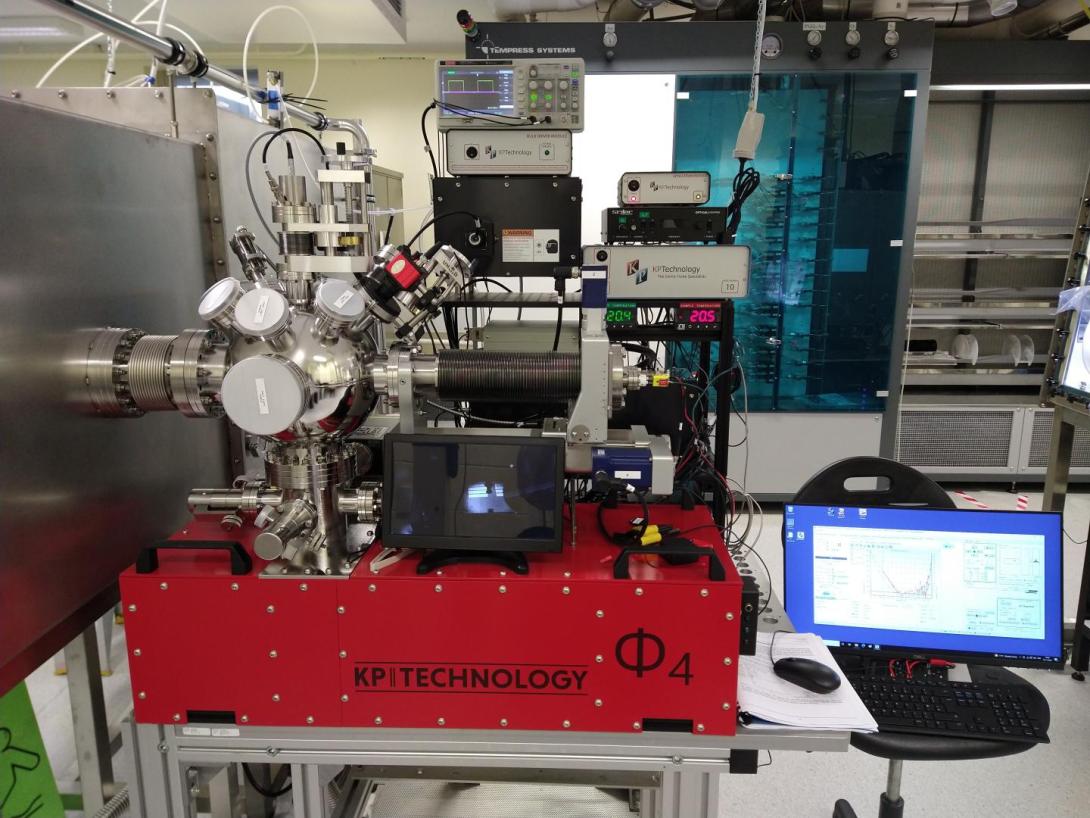KP Technology Φ4 UHV Kelvin probe
Introduction
This system has the capability to measure a wide range of energetic properties of materials including semiconductor absorbers, transport layers, and metals, including work function, ionization potential / valence band energy / HOMO, surface band bending, and bandgap, via Kelvin probe (KP), photoemission yield spectroscopy (PYS), and surface photovoltage (SPV) spectroscopy techniques. It is capable of measurements under ultrahigh vacuum or ambient pressure at temperatures from room temperature to ~500°C, with automated spatial mapping of measured properties available via a motorized sample stage.
Description
Work function (WF) measurements are based on the contact potential difference between the Kelvin probe tip and sample. This may be converted to an absolute value when the WF of the tip is known. This system facilitates determination of the tip work function through its PYS capability, since PYS allows absolute measurements of the work function of metallic samples.
The photoemission yield spectroscopy (PYS) capability uses the Kelvin probe tip as a detector for electrons (or resulting ionised air molecules) emitted from the sample under tuneable monochromatic UV excitation. By extrapolating the resulting yield current (raised to a suitable exponent) vs photon energy to zero, one can determine the ionisation potential (in metals), or the valence band energy / HOMO (in semiconductors). This technique does not require a vacuum (it can be operated at atmospheric pressure), although the yield typically increases under vacuum.
Surface photovoltage (SPV) measurements involve measuring the change in work function between darkness and strong illumination. In a semiconductor, the latter results in a very large excess carrier population, which effectively flattens the bands near the surface, and therefore SPV can be used to probe surface band bending. Surface photovoltage spectroscopy (SPS) measures surface photovoltage as a function of photon energy. This results in a spectrum that is similar to an absorption or PL excitation (PLE) spectrum, from which band gap can be extracted in a similar way.
The KP and PYS capabilities of the system provide information similar to that often obtained using Ultraviolet Photoelectron Spectroscopy (UPS). However, UPS has the disadvantage that it is subject to measurement artefacts due to ionisation of adsorbed surface molecules (e.g. H2O) by high-energy UV photons. This can result in large changes in the apparent sample work function for many commonly studied materials (e.g. TiO¬2, ITO). This is particularly a problem when exposure of samples to atmosphere cannot be avoided. The KP system uses a much lower energy UV source for PYS (and no excitation at all for KP measurements) and is not subject to such artefacts. It also allows mapping of WF, which is not usually possible using UPS.
Unlike the scanning Kelvin probe mode in an AFM system, this system performs mapping on a macroscopic scale. Although the spatial resolution is lower, this can be advantageous (e.g. allowing mapping of variation over larger length scales to check process uniformity), and unlike most SKP/AFM systems it yields accurate absolute values.
The ability to perform WF measurements simultaneously with controlled in-situ sample heating up to 500°C provides the possibility to study the temperature dependence of WF or the effects of annealing on material properties.
Capabilities
- Absolute work-function measurements (mV resolution) using macroscopic Kelvin probe (2 mm standard tip diameter)
- Photoemission yield spectroscopy (3.4–7.0 eV)
- Surface photovoltage and surface photovoltage spectroscopy (1.2–3.1 eV)
- Automated spatial mapping of WF or SPV using motorised sample stage (2 cm x 5 cm scan range, ~5 μm minimum step size)
- Controlled sample heating to 500°C
- Ability to combine with other in-situ optical measurements (e.g. ellipsometry)
- Glove-box interface for ambient-free sample transfer
